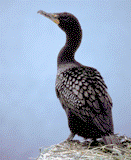United States Department of Agriculture, National Wildlife Research Center: Symposia

Symposium on Double-Crested Cormorants: Population Status and Management Issues in the Midwest
Date of this Version
December 1997
Abstract
Sport and commercial fishing interest groups are concerned about potential impacts double-crested cormorants (Phalacrocorax auritus) may have on fish species. Our objectives for this study were to determine the diet of the cormorant in western Lake Erie and the diet overlap and competition for resources with piscivorous fish, such as walleye (Stizostedion vitreum.) The stomach contents of 302 double-crested cormorants collected in western Lake Erie consisted primarily of young-of-the-year gizzard shad (Dorosoma cepedianum), emerald shiner (Notropis atherinoides,) and freshwater drum (Aplodinotus grunniens). In the spring, freshwater drum were the most frequently occurring food in the stomachs and constituted the greatest portion of the diet by weight. Young gizzard shad became the most abundant prey and made up the largest percentage of the diet by weight in the stomachs from the end of July through October. Emerald shiners were abundant in the diet during June, September, and October. The fish species that cormorants ate resembled, by proportion, the species mix found in trawl catches. The diets of cormorants and walleyes were similar from July to October with significant overlap. Results from this study suggest impacts of cormorants at current population levels in Lake Erie are not detrimental to sport and commercial fishing. Therefore, control for the purpose of reducing competition for prey fish with walleye is not warranted at this time.

